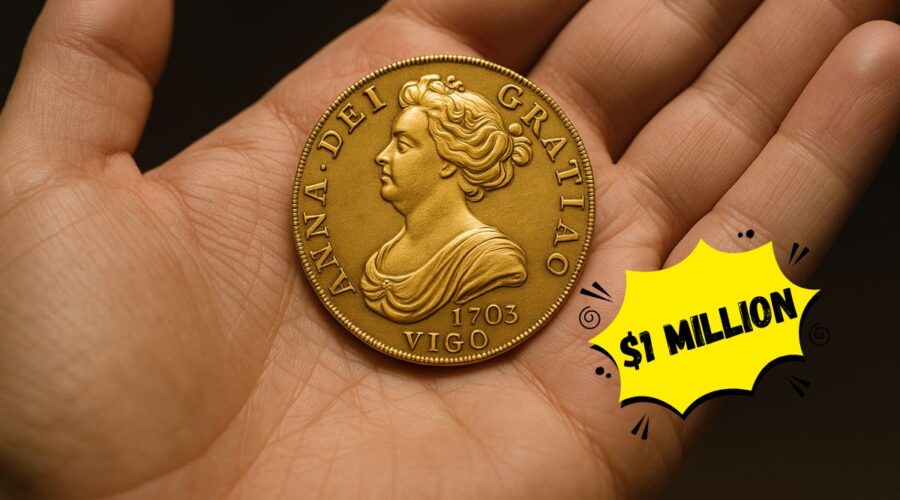1703 Queen Anne Vigo Five-Guineas: Why This Coin Is Worth Over $1 Million Today
Few coins carry the mystique and price tag of the 1703 Queen Anne “Vigo” five‑guineas. Struck from gold seized in the Battle of Vigo Bay, this rare piece has soared past $1 million, commanding record-breaking prices and forever altering numismatic history.
In this deep dive, we uncover the fascinating story behind its minting, rarity, historical significance, auction milestones, and current market value—complete with a detailed facts table, FAQs, and SEO-boosting keywords.
A Coin Carved from History
Context of the Battle of Vigo Bay (October 23, 1702)
During the War of Spanish Succession, an Anglo-Dutch fleet captured or destroyed French and Spanish ships at Vigo Bay. This event netted 4,504 lb of silver and a mere 7 lb 8 oz of gold, a treasure significant enough to mint special “Vigo” coins.
The Royal Warrant & Newton’s Role
Queen Anne, through a royal warrant dated February 10, 1703 (old style), authorized that gold from Vigo be used for special coinage, inscribing “VIGO” beneath her bust. Mint Master Isaac Newton orchestrated the dies, marking a pivotal melding of science and statecraft.
2. Rarity: The Heart of Value
Limited Production Runs
These coins were minted in exceedingly low numbers—fewer than 20 examples are known today. This scarcity is further heightened by the existence of only three known obverse dies, with one variety (where “VIGO” is located near the shoulder) considered the rarest.
Survivor Count
Numismatic sources confirm that fewer than 20 specimens remain, cementing its status as one of the rarest gold coins from Queen Anne’s reign.
Coin Specifications & Design
| Feature | Detail |
|---|---|
| Denomination | 5 guineas (107 shillings 6 d or £5 7s 6d pre‑1717) |
| Gold Content | 41.75 g, 91.67% purity (~1.2309 oz AGW) |
| Fineness | .9170 |
| Diameter | 37 mm |
| Obverse Design | Draped bust of Queen Anne, “VIGO” below |
| Reverse Design | Four crowned cruciform shields, sceptres, central rose |
| Edge Inscription | “DECUS ET TUTAMEN ANNO REGNI SECVNDO” (Latin) |
Auction Highlights & Milestones
Record Auction Sale – January 13, 2019
Lot 69, graded PCGS MS‑62, sold for a hammer price of $900,000, with fees taking the final tally to $1,080,000—setting a world record for a British coin.
Recent Auction Listings
In 2024, an NGC MS‑61 PL specimen from the Peh Family Collection was estimated at $300,000+. Meanwhile, several 2024–2025 auction listings for “Vigo” coins ranged from £40,000 to £50,000 at Spink, depending on condition.
Intrinsic Value: Beyond Collectibility
Bullion Value
As of May 25, 2025, the gold melt value stands around $4,133.71—a fraction of its numismatic worth.
Price Comparison
Typical “Vigo” five‑guineas trade between $300,000–$750,000, with top-tier coins (MS‑62 or rarer die types) breaking the $1 million barrier.
Why It’s a Million-Dollar Icon
- Historical Clout – Minted from Vigo gold, each coin embodies a naval victory and early 18th-century geopolitics.
- Provenance & Authentication – Certified coins graded by PCGS or NGC command premiums.
- Extreme Scarcity – Less than two dozen survive.
- Iconic Design – The “VIGO” inscription and classical imagery elevate its visual and historical appeal.
- Record-Breaking Auctions – The $1.08 million sale in 2019 cemented its legendary status.
Market Outlook & Collector Appeal
Investment Potential
High-grade pieces remain in private collections; as public auctions reveal fewer top-quality specimens, prices are likely to appreciate.
Collector Magnetism
Coin enthusiasts prize it not just for gold or mint quality, but for its story-rich provenance, making it a centerpiece in royal and battle-themed collections.
The 1703 Queen Anne “Vigo” five‑guineas is more than just a rare gold coin—it’s a vessel of history. Minted from the spoils of a naval triumph, struck under Isaac Newton’s supervision, bearing a powerful royal inscription, and surviving in astonishingly low numbers, it commands attention and value.
Each auction result confirms its irreplaceable worth, with collector demand fueling its ascent beyond the million-dollar mark. Whether you’re drawn by its story, its scarcity, or its aesthetic beauty, this coin stands as a shining emblem of why history and numismatics remain inextricably linked.
The 1703 Queen Anne “Vigo” five‑guineas has transcended its material composition. From the chaos of war, through the mind of a scientific genius, into the hands of collectors—it remains a timeless treasure and a benchmark for historical coinage value.
FAQs
Why is the “Vigo” inscription significant?
The word “VIGO” underlines gold sourced from the Battle of Vigo Bay—an intentional tribute to British naval victory inscribed by royal decree for posterity.
How many 1703 “Vigo” five‑guineas survive today?
Fewer than 20 verified examples exist, all exhibiting slight die variations which further influence rarity and collector value.
What makes the coin’s value skyrocket past bullion?
Its worth isn’t about gold—it’s the historical provenance, minting rarity, collector demand, and record auctions that push its price into the seven-figure realm.

Leave a Reply Cancel reply